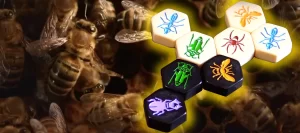Since its original release in 2001, multi award-winning Hive has been frequently compared to the board game don – chess.
The comparisons are understandable – both are abstract strategy games whose pieces have unique movement characteristics, and both focus on trapping one piece to win the game.
wot no board?
Hive’s lack of board is the key difference – players take turns to either move one of their existing pieces or lay down and tessellate a new hexagonal piece adjacent only to existing pieces of their colour.
Each player begins with 11 tiles: 2x spiders, 2x beetles, 3x grasshoppers, 3x ants and a bee.
trap queen bee
The objective is to trap your opponent’s bee tile – to have all 8 hexagonal sides surrounded by tiles of either colour.
Your bee tile must be played no later than the fourth turn.

The spider moves exactly three spaces around the outside of the Hive.

The beetle’s movement is limited to one space but can move across the top of other playing pieces.
When atop another tile, that tile is pinned and cannot be moved.

The grasshopper can leap across multiple tiles in to an unoccupied space.

The ant can flexibly move to any other vacant position around the Hive.
instant appeal
Hive is instantly appealing with its large colourful, chunky hexagonal tiles, cool insect theme, and freeform ‘board’.
It takes minutes to learn the tile movement rules for the five different insects pieces, but many games to master the strategic nuances.
Hive should not be mistaken as a simple kid’s game. Far from it – it’s layers of strategy are many and varied, with several books written on the best opening moves and international championships staged each year.
There are two distinct editions available (ignoring the monochromatic ‘Hive Carbon’ for a minute) – the standard edition and a lighter, smaller – “Pocket Edition”.
Both use the identical ruleset, save that the pocket edition includes two expansion tile sets – the mosquito and the ladybug which add some interesting new dynamics, and can be purchased separately for the standard edition.
Of the two editions (I own both) I would recommend the pocket edition – the cheaper price represents much better value in my opinion, plus you benefit from the addition of the two extra insect types which would cost an additional £5 to £6 each (EUR6-7 / USD7-8) if purchased in the larger tile format. It also packs away into a conveniently sized pocket size drawstring bag that’s light and makes it an ideal travel game.
Yes, the larger brother also packs away neatly into a tidy zip bag, but it’s hardly pocket size – if you manage to squeeze this in to a pocket questions will be asked!

tactile joyNevertheless, the larger tiles (38mm across, 12mm thick) are a tactile joy to play with and do have a more luxurious and weightier feel than the dinkier pocket edition tiles (24mm across, 9mm thick).
The larger standard edition is probably more suited as a gift for an adult, chess, or strategy game nut who doesn’t already own a copy.
Chess may remain the ultimate strategy game of kings (for now), but if I was a kid, I know which one I’d get more excited about playing!
Moderate
2
30 mins
Moderate
Incredible strategy game for 2 players. Minutes to learn, decades to master. This is a modern classic.
If you click on a link and make a purchase I may receive a small commission at no additional cost to you. Learn about site monetization

